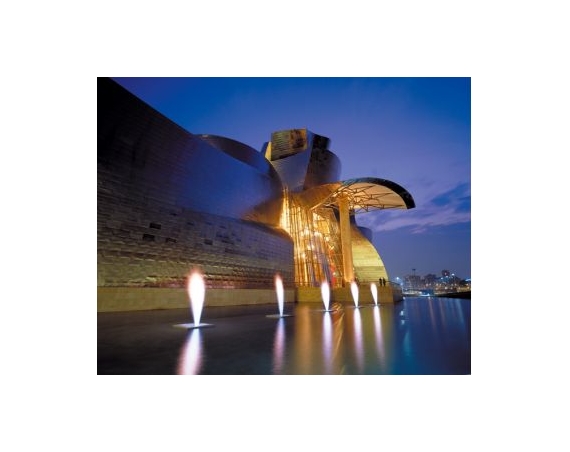Site-specific and outdoor installations by contemporary artists, responding to the spaces of the
Frank Gehry building, are integral to the collection of the Guggenheim Museum Bilbao.
Jenny Holzer (b. 1950, Gallipolis, Ohio, U.S.A.) reacted to the irregular shape of Gallery 101 by filling the space with nine double-sided LED-sign columns, a medium generally used for advertising purposes. As in previous works, she uses language as a primordial material and borrows strategies from mass culture to explore direct access to a large public. Although first written for an AIDS fund-raising event, the aphorisms in Installation for Bilbao (1997), transmitted in Basque, Spanish, and English, evoke universal themes of intimacy, deception, death, and loss. On permanent display outside the museum, Puppy (1992) by
Jeff Koons (b. 1955, York, Pennsylvania, U.S.A.) engages past and present. This 12-foot flowered sculpture, formed from a stainless-steel structure and designed with sophisticated computer modeling, references 18th-century formal gardens. A West Highland terrier-originally a carved wooden sculpture-Puppy combines the most saccharine of iconography-flowers and puppies-in a monument to the sentimental. Tulips (1995-2004), is an enormous polychrome structure in transparent colour-coated chrome stainless steel portraying a bouquet of seven tulips measuring approximately five metres to form an artwork of 203 x 460 x 520 cm. The tulips are conceived like enormous luminescent coloured balloons, transmitting a feeling of weightlessness contrasting with the heavy material of their construction to increase the irony of the piece. Their artificial appearance is the perfect reflection of the subject approached by Jeff Koons in his Celebration series and other sculptures like Balloon Dog and Moon. Consisting of five separate fountains pouring fire into the sky, and envisaged for an open public space, Fire Fountain (1960-61), by French
artist Yves Klein (b. 1928, Nice; d. 1962, Paris), is the most ambitious of his fire pieces and existed only in sketches before its fabrication for the Guggenheim Museum Bilbao.The artist's use of fire as a medium extended in form at Krefeld, Germany, during his 1961 retrospective, to his fire drawings and fire paintings, as well as his projects for an architecture of air, fire, and water, elements that were to provide the walls of his proposed utopian communities. With the ephemeral quality of her installations,
Fujiko Nakaya (b. 1933, Sapporo, Japan) has been experimenting with the artistic potential of artificially produced water-fog in environmental pieces since 1970s. Initial development for her fog installations was provided by Experiments in Art and Technology, a New York-based organization for promoting artistic and technological collaborations founded by
artist Robert Rauschenberg and engineer Billy Kluver. Her installation Fog Sculpture # 08025 (F.O.G.) (1998), specially commissioned for the water-garden area of the back of the building, is an atmospheric sculpture shaped instantaneously by the environment where it is created. Over a career that spans more than six decades,
Louise Bourgeois (b. 1911, Paris) has created a rich and ever-evolving body of work that oscillates between abstraction and the visceral representation of psychic states. Part of her recent Spider series, the graceful, bronze Maman (1999), installed behind the building, addresses the duplicitous nature of maternity; the silk of a spider is used both to construct cocoons and to bind prey.
Bourgeois explores the complexity of the human mind, publicly exorcising her emotional demons and poetically re-creating childhood associations in the form of a gigantic insect.




